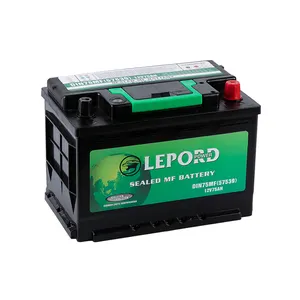(50090 products available)






































































































































































































































A car battery 200 is a rechargeable battery that powers vehicles. It is a crucial component of vehicles because it stores electrical energy and releases it to power the starter motor and other electrical accessories. Car batteries come in different types, including:
Lead-Acid Batteries:
These are the most common batteries and the ones mostly used in vehicles. They are made with lead and sulfuric acid. When the battery is charged, it creates a chemical reaction that generates electrical energy. This energy powers the vehicle's electrical components and starts the engine. Lead-acid batteries are affordable and simple to manufacture. They have a high surge current, which is suitable for starting engines. However, they have a low energy density and cannot be deeply discharged without damaging the battery.
Lithium-Ion Batteries:
These batteries are becoming common in vehicles. Lithium-ion batteries have higher energy density and are lighter compared to lead-acid batteries. They also have a higher discharge rate, which means they can power devices for longer without running low. Moreover, lithium-ion batteries have a longer cycle life and deep discharge capabilities. They can be discharged up to 80% without damaging the battery. This makes them suitable for powering electric vehicles. On the downside, lithium-ion batteries are more expensive than lead-acid batteries, and they require special management systems to ensure safety and performance.
Absorbent Glass Mat (AGM) Batteries:
AGM batteries are a type of lead-acid battery. They are designed with fiberglass mats that absorb the electrolyte. This makes AGM batteries spill-proof and allows them to be mounted in different positions. They have a high discharge rate and can deliver a lot of current in a short time. AGM batteries also have a low internal resistance and a longer cycle life. Because of these features, AGM batteries are mainly used in start-stop vehicles and hybrid electric vehicles. They are also suitable for powering deep-cycle applications.
Gel Batteries:
These are also lead-acid batteries. Gel batteries use silica to turn the electrolyte into a gel. This makes the electrolyte stable and reduces stratification. Gel batteries are maintenance-free and can operate in different temperature ranges. They also have a low self-discharge rate and are suitable for deep-cycle applications. However, gel batteries have a low discharge rate, and charging them can be slow.
Nickel-Metal Hydride (NiMH) Batteries:
NiMH batteries are also used in vehicles. They are designed with nickel and hydrogen, which gives them a higher energy density compared to other batteries. NiMH batteries have a higher cycle life and can be charged and discharged many times. They also have a low internal resistance and a high discharge rate, which makes them suitable for powering hybrid electric vehicles. On the downside, NiMH batteries suffer from the memory effect, which reduces their capacity over time.
Here are some general specifications to look for when sourcing for a 200AH battery:
The type of battery
Car batteries come in different types, each with its construction and chemistry. The most common types are lead-acid batteries, lithium-ion batteries, and AGM batteries. Lead-acid batteries are the most common and also the cheapest. They are affordable for most people. On the other hand, lithium-ion batteries are the most expensive and have a higher energy density.
Size and terminal type
Car batteries come in different sizes. The battery size should be compatible with the battery tray. The standard sizes for car batteries are BCI group 24, 27, 31, and 49. Also, look for the standard terminal types. Car batteries have top post, side post, and jump post terminals.
Cold cranking amps
Cold cranking amps refer to the maximum current a battery can deliver at 0 degrees Fahrenheit for 30 minutes without dropping below 7 volts. Look for a 200ah deep cycle battery with a CCA rating between 800-1200.
Voltage
Most car batteries are designed with a 12-volt system. However, some high-performance batteries have a 16-volt system. The 12-volt batteries are more compatible with most cars. They also require less maintenance.
Here are some general tips for maintaining a car battery:
Choosing the right car battery is vital for business operations. Here are some crucial factors to consider when selecting a proper car battery:
Battery Size:
Different cars have different batteries depending on the size and model. The batteries are categorized using the BCI (Battery Council International) numbering system. Make sure to choose a battery that is compatible with the car.
Battery Type:
There are various types of batteries suitable for different cars. Car batteries are classified into AGM batteries, Gel Cell Batteries, and Lithium-Ion Batteries. Lithium batteries have a higher CCA and are more expensive than other batteries. Choose a battery that is compatible with the car.
Cold Cranking Amperage (CCA):
Cold Cranking Amperage refers to the power the battery gives to start the car, especially in cold weather. The battery chosen should have a higher CCA rating so that it can start the car easily even in cold weather.
Reserve Capacity (RC):
Reserve capacity is the duration the battery will run essential functions in the car without the help of a recharge. Choose a battery with high reserve capacity so that it can support the car for a long time.
Warranty:
Most batteries come with a warranty. The warranty period acts as a guarantee to the buyer that the battery is in good condition and will serve its purpose. Choose a battery with a long warranty period.
Car owners may replace their batteries 200 on their own, provided they have the necessary skills. First, they need to gather the required tools, including a ratchet and socket set, battery terminal brush, safety goggles, battery pedestal, battery gloves, and fire extinguisher. Then, they can follow the step-by-step guide below:
1. Prepare
Ensure the vehicle is parked in a safe, well-ventilated area. Turn off the ignition, engage the parking brake, and make sure the vehicle's electronic devices are not used. Using the appropriate screwdriver, car owners should loosen and disable the negative first and positive terminals.
2. Remove old battery
After removing the battery cables, car owners should remove any battery hold-down clamps and other securing devices. Then, lift the battery out of the battery tray with the battery handles.
3. Clean the battery tray and terminals
Car owners should clean the battery tray, eliminating any debris, dirt, and rust. They also need to clean the battery cables and terminals using a wire brush to ensure a good connection.
4. Install the new battery
Place the new battery in the battery tray, ensuring it is in the correct orientation. Reinstall the hold-down clamps or any other securing mechanisms. Then, reconnect the battery terminals, starting with the positive terminal first, followed by the negative one. Ensure the connections are tight and secure.
5. Final checks
Start the vehicle and ensure all electronic components function correctly. Double-check the battery connections and secure installations to ensure everything is in order.
Q1: How long does a 200 amp car battery last?
A1: The lifespan of a 200 amp car battery is influenced by various factors. On average, car batteries last five to seven years. However, a well-maintained car battery can extend up to ten years.
Q2: How do customers maintain a 200 amp car battery?
A2: Car owners can do several things to maintain and prolong the lifespan of a 200 amp car battery. First, they should conduct regular battery inspections. This helps to identify corrosion and loose connections, which are the main causes of battery drain. Secondly, they should clean the battery terminals. Cleaning the battery terminals is essential to prevent the buildup of corrosion. Third, they should ensure proper ventilation. Car owners should ensure that the battery is well-ventilated to prevent overheating, which is a major cause of battery damage.
Q3: Why is a 200 amp car battery suitable for high-demand vehicles?
A3: The 200 amp car battery is designed for vehicles that require a higher power supply to operate. These vehicles include trucks, buses, and other commercial vehicles. The battery supports the starting power and operates additional accessories like infotainment systems, GPS, and power outlets.